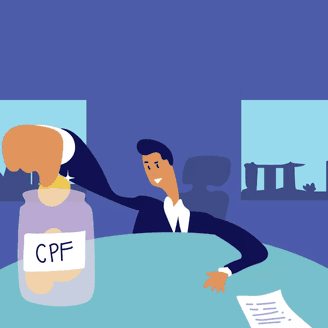- Osome Blog SG
- A Guide to Central Provident Fund (CPF) for New Employers
A Guide to Central Provident Fund (CPF) for New Employers
- Modified: 20 September 2024
- 11 min read
- Money Talk


Syahirah Aiman Abbas
Business Writer
Syahirah Aiman Abbas is a writer and translator who loves languages. After learning Malay, English, Arabic, Indonesian and French, now she is on to Turkish!
When you set up your company in Singapore, you will have to eventually hire to grow your business. As an employer, you have a responsibility and legal obligation to provide basic employment rights to your employees. One of them is to contribute to the Central Provident Fund (CPF) of staff who are citizens of Singapore or Permanent Residents.
Most employees take time to do this right as there are heavy penalties for non-compliance. It can get really overwhelming especially when it is the first time you are going through the process, but get it right the first time and you will set your business up for success. By the way, if you have any questions on bookkeeping and accounting as you set up and grow your business, we’d be glad to help.
What Is the CPF?
The Central Provident Fund in Singapore (CPF) is a compulsory, employment-based savings scheme for Singapore Citizens and Permanent Residents (SPRs).
Under the CPF scheme, which is a key component of Singapore's social security system, all Singaporeans and SPRs are required to make regular monthly payouts to the Fund deducted by their employers from their monthly salaries, which invests the proceeds on their behalf for their healthcare, home ownership, retirement savings and family insurance.
Additionally, we offer company incorporation services to assist entrepreneurs in setting up their businesses, ensuring compliance with local regulations while also navigating the CPF requirements effectively.
CPF Retirement Account
One of the key pillars of the CPF system, integral to Singapore's social security framework, is its focus on retirement savings. CPF members’ contributions are designed to build up a significant retirement account, ensuring financial security for their later years. When members reach the age of 55, a retirement account (RA) is created, consolidating funds specifically for retirement purposes. This account plays a central role in the CPF system’s objective to help individuals build up enough retirement savings to sustain them throughout their retirement years.
At 55, members are required to set aside a Basic Retirement Sum (BRS) or Full Retirement Sum (FRS) in their retirement account. These retirement savings are intended to provide monthly payouts under the CPF LIFE scheme, which starts when members reach age 65. CPF LIFE is a lifelong annuity plan that ensures members receive steady payouts from their retirement account for as long as they live. With CPF LIFE, members can enjoy the security of knowing that their financial needs will be met throughout their retirement. The CPF system encourages long-term accumulation of retirement savings, helping members prepare financially for their retirement while benefiting from CPF’s secure investment strategies.
Through the CPF, Singaporeans and SPRs can enjoy peace of mind, knowing that their retirement savings are being professionally managed and that their retirement account will provide financial stability in their later years.
As a Business Owner, Do I Need To Contribute to My Own CPF too?
If you own a Sole Proprietorship or Private Limited Company, and earn a yearly Net Trade Income (NTI) of more than SGD $6,000, you are only required to contribute to your MediSave account annually.
Your NTI is your gross trade income minus all allowable business expenses, capital allowances and trade losses as determined by The Inland Revenue Authority of Singapore (IRAS).
What is MediSave account?
MediSave is a national medical savings scheme that helps individuals set aside part of their income to pay for their personal or approved dependents' hospitalisation, day surgery and some allowed outpatient expenses, as well as their healthcare needs in old age. You can also top up your CPF Ordinary Account or Special Account but on a voluntary basis, it’s not compulsory.
The Singapore government encourages your CPF contribution to MediSave account, because of these plus points:
You can use MediSave savings for
- Healthcare expenses for yourself and your family;
- Premium payment for MediShield Life or MediSave-approved private integrated plans.
- You can get 4-6% interest per annum on your MediSave savings, so that you will not lose your money from inflation;
- You can get tax relief of up to 37% of your annual Net Trade Income.
What are the rates for MediSave contribution?
The Singapore Employer CPF contribution percentage is the following:
Age | Income(NTI): Above $6,000-$12,000 | Above $12,000-$18,000 | Above $18,000 |
|---|---|---|---|
| Below 35 | 4% | 4-8% | 8% (Max: $5,760) |
| 35-45 | 4.5% | 4.5-9% | 9% (Max: $6480) |
| 45-50 | 5% | 5-10% | 10% (Max: $7200 |
| 50 and above | 5.25% | 5.25-10.5% | 10.5% (Max: $7,560) |
What are the steps and timeline to contribute?
- First, you will need to declare your actual income and file your Income Tax.
- Next, IRAS will send you a Notice Of Assessment (NOA).
- Then, IRAS will send you another letter called the Notice Of Computation (NOC), where your actual MediSave payable will be stated.
- Your contribution must be made within 30 days of the date stated in the Notice of Computation. This can be done at any CPF service centre or online using your SingPass. Alternatively, you can just do a voluntary top-up to your MediSave account, boosting your CPF savings for future healthcare and retirement needs.
How to pay:
- The most convenient way is to pay online via eNETS Debit Payment. The participating banks are DBS/POSB, UOB, Citibank, OCBC and Standard Chartered Bank.
- You could also set up monthly GIRO payments online, or pay via NETS at SingPost branches and AXS Machines islandwide, ensuring that your contributions to CPF savings are kept up-to-date.
What About My Staff, How Do I Calculate How Much CPF To Pay Them?
Follow these 4 easy steps to figure out how much CPF contribution you need to pay for your employees and grow their CPF savings:
- Identify if you need to pay CPF for those employees.
- Find out which wage payments you will need to pay CPF contributions on.
- Classify wages as ordinary wages and additional wages.
- Apply the CPF contribution rates.
Step 1: Identify If You Need To Pay CPF for Your Employees
Once you start to hire employees, you’ll need to make CPF contributions to build your staff's CPF savings. All CPF contributions must be paid solely by you.
Take a look at which types of staff you need to contribute to CPF savings for, and which types of staff you don’t have to:
Need to contribute to CPF | Don’t have to contribute to CPF |
|---|---|
| Singapore Citizens or Permanent Residents earning more than $500 per month. (full-time, part-time, ad-hoc, or contract basis, and even during their probation period) | Singapore Citizens or Permanent Residents earning more than $500 per month. (full-time, part-time, ad-hoc, or contract basis, and even during their probation period) |
| School-leavers or students working on a part-time or temporary basis under a contract of service on their vacation. These include students who work in November or December after completing their ‘A’ level examinations, a national examination taken to enter University, or its equivalent, e.g. Diploma from Polytechnics, Certificates from Institutes of Technical Education. | Students who work during their term time or school holidays (i.e. not final year holidays, for post-secondary institutions) |
| Company directors engaged under a contract of service and paid a salary on top of any fee received | Tertiary students employed under training programmes approved by local government higher education institutions |
| Citizens or Singapore Permanent Residents working overseas | |
| Foreigners holding Employment Pass, S Pass, Miscellaneous Work Pass or Work Permit | |
| Directors’ fees voted to company directors at General Meetings |
What is an Employer?
An employer can be:
- Any person, company, association, or organisation, whether or not incorporated, who employs a worker;
- Any agent or person responsible for paying an employee’s salary, on behalf of an employer.
What is an Employee?
An employee is:
- Any Singapore Citizen or Singapore Permanent Resident who is employed in Singapore under a contract of service by an employer;
- Any Singapore Citizen or PR who is employed under a contract of service or an agreement, in Singapore, as a master, a seaman or an apprentice in any ship where the owners are not exempted from the CPF Act.
Your employees include:
- Company directors;
- Employees holding two or more jobs;
- Family workers;
- NSmen on in-camp training;
- Part-time employees;
- Temporary or casual employees.
Step 2: Find out Which Wage Payments You Will Need To Pay CPF Contributions on
These are 6 payments for your employees that you will need to include when calculating CPF contributions to grow their CPF savings:
- Basic wages
- Overtime pay (for workmen and employees with basic monthly salaries not exceeding $4,500 and $2,600 respectively)
- Cash incentives (e.g. Good service awards)
- Allowances (e.g. meal, transport, laundry)
- Bonuses
- Commissions
Example
Rafa is the boss of a small private limited company, Rafa Enterprise Pte. Ltd. He has two employees, Patrick, a Singapore aged 45 years old who works full-time, and Rama, a 16 years old secondary school student who works occasionally on weekends when it is busy. Patrick earns $3,000 per month and receives no bonuses nor additional allowances. Rama earns $10 per hour.
Rafa Enterprise needs to only pay for Patrick’s CPF contributions to build his CPF savings, as Rama is a student working during his term time.
Patrick’s monthly Total Wages = Ordinary Wages + Additional Wages = $3,000 + $0 = $3,000
Rafa Enterprise needs to pay (Employer’s contribution) to Patrick’s CPF savings: 17% x $3,000 = $510 and
Patrick’s salary would be deducted (Employee’s contribution) for his CPF savings at: 20% x $3,000 = $600
Total CPF Contribution is $1,110.00, which will be allocated to his CPF savings across three accounts: Ordinary Account $630.15, MediSave Account $269.95 and Special Account $209.90.
You could also try using this tool to calculate your own CPF contributions here.
Step 3: Classify Wages as Ordinary or Additional Wages
As the Central Provident Fund contributions you would have to pay for your staff are calculated based on an employee's total wages, the total wages for any calendar month is the sum of an employee's Ordinary Wages (OW) for the month and the Additional Wages (AW) paid to him in that month.
Formula: Total Wages = Ordinary Wages + Additional Wages
It is important for employers to know the correct type of wages because there are different ceilings for OW and AW. This, in turn, will affect the amount of CPF contribution payable.
What are Ordinary Wages?
Ordinary Wages (OW) are:
- Wages due or granted wholly and exclusively in respect of an employee's employment in that month; and
- Wages payable before the due date for payment of CPF contributions for that month.
An example of Ordinary Wage is the monthly salary.
The Ordinary Wage (OW) ceiling limits the amount of OW that an employer needs to make CPF contributions on. The OW Ceiling is capped at $6,000 currently. For example, even if an employee’s ordinary wage for a calendar month is $6,500, his CPF contribution would be limited to an OW of $6,000; CPF contribution is not required on the remaining $500.
What are Additional Wages?
Additional Wages (AW) are:
- Wages which are not granted wholly and exclusively for the month; or
- Wages made at intervals of more than a month.
Examples of AW are annual bonus and leave pay.
The amount of CPF contributions payable on AW is capped at the yearly AW Ceiling of
$102,000* – Total OW subject to CPF for the year
*Equivalent to 17 months x $6,000
The AW Ceiling is applied on a per employer per year basis. As an employer, you would need to monitor and limit the contributions on Additional Wages of their employees.
Step 4: Apply the CPF Contribution Rates
You may now be asking yourself: How much is the employer’s CPF contribution rates? Or, How to calculate CPF contribution rates?
All companies in Singapore are required to deduct a portion of their employee’s salary (usually 20%) and contribute an additional 17% for their employee. The employer pays their employee’s share of Central Provident Fund (CPF) contributions monthly if the employee is paid more than S$500 per month, ensuring that they can benefit from monthly payouts in the future.
Here’s a breakdown of the age and percentage contribution:
Age of Employee | CPF contribution by Employer | CPF Contribution by Employee | Total Contribution Rate |
|---|---|---|---|
| Up to 55 years old | 17% | 20% | 37% |
| 55 to 60 years old | 13% | 13% | 26% |
| 60 to 65 years old | 9% | 7.5% | 16.5% |
| Above 65 years old | 7.5% | 5% | 12.5% |
When is the due date for CPF Contributions, and what happens if I miss the deadline?
The due date for CPF contributions from employer is on the last day of the calendar month. There is a grace period for employers until the 14th of the following month (or the next working day if the 14th falls on a Saturday, Sunday or Public Holiday).
After that, late payment interest would be charged at 1.5% per month commencing from the first day after the due date. Enforcement action may be taken against employers who fail to pay by the 14th of the following month (or the next working day if the 14th falls on a Saturday, Sunday or Public Holiday). Save money by paying on time and being compliant!
Example
XYZ Pte Ltd made a CPF contribution of $3,000 for the month of October on 20 November 2014. This payment is late by 19 days. Therefore, the amount of late payment interest will be:
= $3,000 x 1.5% x 19/30 (stop at the 4th decimal)*
= $28.50
*Number of days the payment is late/number of days in the month.
Who is not eligible for CPF contributions?
CPF contributions are not allowed for foreigners holding Employment Pass, S Pass, Miscellaneous Work Pass or Work Permit.
When do foreigners need to contribute CPF?
CPF contribution for foreigners is obligatory if they have been a permanent resident in Singapore for two years. During this period, CPF contribution rates are reduced.
I’m a New Boss. What Are the Exact Steps To Pay My Staff’s CPF?
After incorporating your company in Singapore, you might decide to hire employees. As a new employer, you would first need to register with the Singapore Central Provident Fund Board.
These are the steps that you should take to credit your staff’s CPF contributions:
- Apply to e-submit your CPF contribution details using CPF e-Submit@web as soon as you intend to hire your first employee. You will need your SingPass/CorpPass and your company's Unique Entity Number (UEN).
- Once your application is approved, you will be notified via email. You will also receive a hardcopy letter which contains your CPF Submission Number (CSN) and a Direct Debit Authorisation form, both of which are needed to pay your and your staff’s CPF contributions.
- After your payment has been processed, you will receive an email notification to view the electronic Record of Payment (eROP).
- Please check your eROP and inform the Central Provident Fund Board immediately of any discrepancy. The eROP should be kept for future reference.
What is the CPF Submission Number (CSN)?
The CPF Submission Number (CSN) that you received via mail mentioned above, would then be used to transact with the CPF Board.
The CSN comprises your UEN and CPF Payment Code, except in these cases:
- For employers who are individuals hiring local employees such as a personal driver, gardener and local domestic worker, the CSN is the 'NRIC/Foreign Identification Number (FIN) + CPF Payment Code'; and
- For individuals hiring foreign domestic workers or individuals who are self-employed, the CSN is the individual's NRIC/FIN.
What is the CPF e-Submit@web?
CPF e-Submit@web is the CPF Board’s online platform where CPF contribution details are submitted electronically. It helps you calculate CPF contributions rates automatically, giving the breakdown of employer’s and employee’s rates. It also auto-updates when an employee moves to a different age group, or changes his Singapore Permanent Residency status.
It is secure, as login is authenticated via SingPass/CorpPass and restricted only to company’s authorised staff. Yours and your staff’s CPF contribution payments made by you can be deducted electronically via Direct Debit, PayNow, and eNETS, when you use the CPF e-submit@web.
What payment methods can I use to pay my employees’ CPF contributions?
There are 3 ways to do this - direct debit, eNETS, or AXS machines:
1 Direct Debit
Direct Debit is the way to go, and the most convenient too, to pay for your CPF contribution payments to the Central Provident Fund Board.
You would need to complete and send the Direct Debit Authorisation (DDA) form to the CPF Board. Next, it will forward it to your bank for processing. The bank takes about 21 working days to process this.
The Board will directly notify you of the Direct Debit arrangement after approval from your bank.
While your DDA application is being processed, you would need to use any of the next few following payment services to pay CPF contributions.
2 eNETS (for CPF e-Submit@web users)
Employers who have personal bank accounts with the following participating banks may initiate the payment online, and deduction will be done from their bank accounts immediately.
Currently, only personal accounts from DBS, POSB, UOB, OCBC, Citibank (Maxisave/Ready Credit) and Standard Chartered Bank are accepted.
3 AXS machines (CPF e-Submit@AXS)
Employers who pay via AXS machines to submit their CPF contribution details may choose between the Diners Club Card or NETS. Maximum transaction amount for Diners Club Card is subject to the card's credit limit, while NETS payment is subject to the daily transaction limit set by your bank.
4 PayNow
PayNow QR and OCBC Pay Anyone payment options are available for all payment services via the myCPF mobile app.
What Do I Do if I Have More Questions? Is There a Hotline?
Call CPF’s number:
CPF Board Hotline 1800-227-1188 for local calls, +65-6227-1188 if you are calling from overseas.
Central Provident Fund does not list a direct CPF email address, however you could write in your CPF related enquiry here in an online form.
Got a Burning Question?
Alternatively, you could always chat with us here at Osome. We will clarify questions that a new boss has when they have just set up their company and are expanding their business, including questions on how to set up a good system of accounting.






